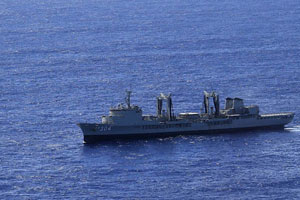PERTH, Australia/KUALA LUMPUR - Chinese and Australian ships have picked up acoustic signals while searching for missing Malaysia Airlines Flight MH370 in the southern Indian Ocean.
The underwater detection represents an "important and encouraging lead," said Angus Houston on Sunday, whose Joint Agency Coordination Center (JACC) is responsible for coordinating the massive multinational hunt far west of Australia's coast.
However, Houston cautioned that the acoustic events need to be treated carefully as "we are working in a very big ocean and within a very large search area."
Chinese vessel Haixun 01 detected a pulse signal with a frequency of 37.5 kHz - the same as those emitted by flight recorders - on Friday in a key search area, and redetected the pings for 90 seconds on Saturday just 2 km away from the original spot.
Following the detection, the JACC asked British vessel HMS Echo and Australian ship Ocean Shield, both equipped with black box detectors, to sail to the area and help verify the signals.
Meanwhile, Houston said Ocean Shield itself picked up an underwater signal on Sunday some 300 nautical miles away from the location of Haixun 01, and was investigating the acoustic encounter.
The detection of the pings came just days before the batteries of the missing jetliner's black box is expected to expire. The Boeing 777 plane has disappeared for 30 days, and that is how long those batteries normally last.
Even if the ill-fated jet was found where Haixun 01 detected the signal, it would be "incredibly challenging and very demanding" as well as time-consuming to recover it, as the water there is about 4.5 km deep, noted Houston.
In parallel with the search, Malaysian authorities are also pressing ahead with investigation in order to find out what really happened to the plane.
Citing expert analysis of satellite, radar and other data available, they concluded earlier that the ill-fated March 8 flight from Kuala Lumpur to Beijing ended in the southern Indian Ocean.
According to previously revealed information, the Boeing 777 aircraft turned back after disappearing from civilian radar over South China Sea, and was detected by Malaysian military radar in the northern Strait of Malacca before vanishing from all radar screens.
After reviewing radar data provided by neighboring countries, investigators have now found that the jetliner curved north of western Indonesia before turning south toward the southern Indian Ocean, U.S. broadcaster CNN on Sunday quoted an unnamed Malaysian official as saying.
The latest finding added to the already prevailing assumption that the plane was flown deliberately along a route designed to avoid radar detection. But so far investigators have not ruled out other possible causes of the plane's diversion, such as mechanical problems.
It remains unknown who the investigators think might have piloted the aircraft, which carried 239 people on board, including 154 Chinese passengers, after it vanished from radar.
 |
 |